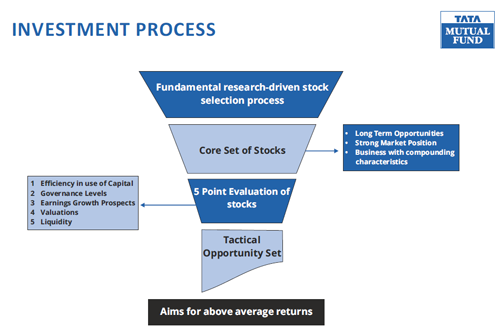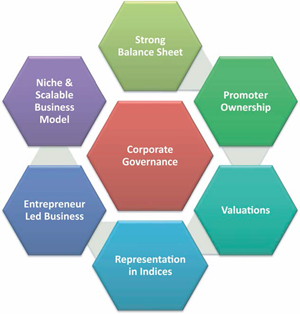Tata Mutual Fund has a history of launching numerous NFOs back-to-back in the past. With the launch of Tata Small-Cap Fund (TSF), Tata Mutual Fund is adding another fund to its table. Notably, the fund house had launched a Multi-cap Fund, a couple of months back in August 2018, apart from two other close-ended value style funds in June and July 2018
Tata Small-cap Fund is an open-ended equity scheme mandated to invest in companies that fall under the small-cap category. As per SEBI’s mandate, Small-cap equity funds should invest at least 65% of their assets in stocks of small-cap companies. SEBI has classified small-cap companies as those that fall beyond the 250th stock in terms of full market capitalization.
Hence, TSF will allocate and incline its assets mainly towards equity and equity related instruments of small-cap stocks, while it could also invest up to 35% of its assets in equity and equity related instruments of other than small-cap companies. From an asset allocation standpoint and to mitigate the risk, the fund may also allocate some portion (up to 35% of its total assets) to debt and money market instruments and units of REITs and InvITs (up to 10% of its total assets).
Generally smaller than their mid-cap counterparts and in the initial development phase small-cap companies have the potential to grow multi-fold to become a formidable business entity. But, small-caps have the tendency to go from thrilling highs to dangerous lows. Moreover, its low trading volume due to their size brings along high liquidity risk. Thus, note that the risk associated with small-cap funds is far greater than mid-cap funds.
On the risk-return matrix, TSF is very-high-risk high-return investment proposition. It is suitable only for investors with a very aggressive risk profile and a time horizon of at least 8-10 years.
[Read: Why Comparing Returns to Risk Is More Meaningful!]
Table 1: NFO Details
| Type |
An open-ended equity scheme predominantly investing in small-cap stocks. |
Category |
Small-cap Funds |
| Investment Objective |
The investment objective of the scheme is to generate long-term capital appreciation by predominantly investing in equity and equity related instruments of small cap companies.
However, there is no assurance or guarantee that the investment objective of the Scheme will be achieved. The Scheme does not assure or guarantee any returns. |
| Min. Investment |
Rs 5,000 and in multiples of Re 1 thereafter |
Face Value |
Rs 10 per unit |
| Plans |
• Direct
• Regular |
Options |
• Growth
• Dividend (Payout and Reinvestment)
*Default option
#Default option for Dividend |
| Entry Load |
Nil |
Exit Load |
1% of the applicable NAV, if redeemed or switch out from the scheme on or before the expiry of 24 months from the date of allotment of units.
Bonus units and units issued on reinvestment of dividends shall not be subject to exit load |
| Fund Manager |
Mr Chandraprakash Padiyartd |
Benchmark Index |
Nifty Small-cap 100 TRI Index |
| Issue Opens |
19th October 2018 |
Issue Closes: |
02nd November 2018 |
(Source: Scheme Information Document)
How will the scheme allocate its assets?
Under normal circumstances, the scheme's asset allocation will be as under:
Table 2: TSF's Asset Allocation
| Instruments |
Indicative allocations
(% of total assets) |
Risk Profile
High/Medium/Low |
| Maximum |
Minimum |
| Equity and equity related instruments^ of small-cap companies$ |
100 |
65 |
High |
| Equity and equity related instruments^ of other than small-cap companies |
0 |
35 |
High |
| Debt and Money Market Instruments including units of debt and liquid schemes of Tata Mutual Fund |
0 |
35 |
Low to Medium |
| Units of REITs and InvITs # |
0 |
10 |
Medium to High |
$ Small Cap companies are those companies which are classified as small-cap companies by Securities and Exchange Board of India (SEBI) or Association of Mutual Funds in India (AMFI). At present Small Cap: 251st company onwards in terms of full market capitalization.
^ The Scheme will comply with all the applicable circulars issued by SEBI as regard to exposure to derivatives viz. SEBI Circular no. SEBI/MFD/CIR No. 03/ 158 /03 dated June 10, 2003, no. DNPD/Cir-29/2005 dated September 14, 2005, no. SEBI/IMD/CIR No. 9/108562/07 dated November 16, 2007, no. Cir/ IMD/ DF/ 11/ 2010 dated August 18, 2010.The cumulative gross exposure to equity, equity related instruments, debt, money market instruments and derivatives shall not exceed 100% of the net assets of the scheme. The exposure to derivatives will not exceed 50% of the net assets of the scheme.
The Scheme may invest upto 50% of the scheme's debt exposure in domestic securitised debt.
#A mutual fund may invest in the units of REITs and InvITs subject to the following:
- No mutual fund under all its schemes shall own more than 10% of units issued by a single issuer of REIT and InvIT; and
- A mutual fund scheme shall not invest
- more than 10% of its NAV in the units of REIT and InvIT; and
- more than 5% of its NAV in the units of REIT and InvIT issued by a single issuer.
(Source: Scheme Information Document)
What will be the Investment Strategy?

(Source: pixabay.com)
TSF will try to achieve its investment objective by predominantly investing in equity /equity related instruments of small-cap companies as well as a small portion in equity and equity related instruments of other than small-cap companies.
The focus of this Scheme is to provide investors with a reasonably diversified portfolio of small-cap stocks. The fund manager may invest across sectors, take cash calls, change allocation between the equity and fixed-income asset classes in a dynamic manner within the permitted limits and use derivatives for trading, hedging and portfolio balancing.
The Scheme may also invest some portion of the investible funds in debt and money market instruments including liquid and debt schemes of Tata Mutual fund as well as in hybrid instruments like REITs & InvITs.
The stocks under the Scheme will be selected after rigorous fundamental research based on the following parameters
-
Management competitiveness,
-
Business competitiveness,
-
Corporate governance,
-
Growth prospects,
-
Past track record, etc.
Figure 1: Investment Strategy Explained

(Source: Tata Small-cap Fund Presentation)
As can be seen from the given diagram, the TSF's investment strategy is like a filtering process, where the fund manager will aim to arrive at a core set of stocks offering long-term opportunities, strong market position and business with compounding characteristics. It will further follow 5 point evaluation process (using the quantitative and qualitative aspects of the companies) to arrive at the final list of stocks for the portfolio. Using the tactical opportunity set, the fund will aim for above-average returns for investors.
Who will manage TSF?
TSF will be managed by Mr Chandraprakash Padiyar.
Mr Padiyar recently joined Tata AMC as a Senior Fund Manager. He is an MBA (Finance) from Symbiosis Institute of Business Management and has cleared all 3 levels of CFA program from the CFA Institute.
Mr Padiyar has over 18 years of work experience in Equity research. Before joining Tata Asset Mangement Ltd in September 2018 as a Senior Fund Manager of Equities, he has worked with Alchemy Capital Management Pvt. Ltd. as Director and Portfolio Manager for on-shore long-only strategies for over a decade.
Some of the other Equity schemes he has been assigned to include Tata Hybrid Equity Fund, Tata Large & Mid Cap Fund and Tata Offshore India Opportunities Scheme.
The outlook for Tata Small-cap Fund:
TSF will strive to achieve the investment objective of capital appreciation by predominantly investing in equity/equity related instruments of small-cap companies.
Based on the fund strategy of stock selection of small-cap companies, the fund manager will try to maintain the investment objective of the scheme.
The rationale behind investing in small-cap stocks is that they have increased over the years and have managed to perform better than the large-cap funds despite the higher risk involved as mentioned in the brochure “Small-caps compared to Large and Mid-caps have a higher spectrum to grow in every aspect of a business”
Figure 2: Small-cap Investing is based on:

(Source: Tata Small-cap Fund Presentation)
In the current market conditions where small-cap and mid-cap companies are beaten down and so have large-caps toppled; it provides an opportunity to do some value buying to the fund manager. However, amidst the extreme turbulence constructing the portfolio would be a challenging task for the lead fund manager, and if the Indian equity markets hit more turbulence ahead that may inflict on extremely-high-risk.
Amidst the macroeconomic uncertainties looming, the fortune of the fund would be closely linked to how the fund manager plays the investment strategy in the endeavour to accomplish the investment objective of TSF.
[Read: Skip NFOs, Instead Consider Building A Strategic Mutual Fund Portfolio ]
Editor's note:
At PersonalFN to handle the turbulence of the Indian equity market we can guide you to invest in the world of finance and enable you to take control of your personal finance.
As you know, “Knowledge is power.”
What if YOU knew what metrics to use to judge a mutual fund upon?
What if YOU knew where to invest your savings now?
What if YOU knew how to hedge your risks for today and tomorrow?
Think about it.
You don’t have to blindly rely on your financial advisor for that. With our Comprehensive A To Z e-Course, you don’t have to be in the dark anymore.
PersonalFN’s Money Simplified e-Class Video Seriescan make you a successful investor or you can play it safe for a happy retirement, this e-Course aims to make you capable of figuring out your life goals and objectives on your own while preparing the ultimate strategy for yourself.

Subscribe now to become your OWN financial planner.
Happy Investing!
© Quanutm Information Services Pvt. Ltd. All rights reserved.
Any act of copying, reproducing or distributing this newsletter whether wholly or in part, for any purpose without the permission of PersonalFN is strictly prohibited and shall be deemed to be copyright infringement.
Disclaimer: Quantum Information Services Pvt. Limited (PersonalFN) is not providing any investment advice through this service and, does not constitute or is not intended to constitute an offer to buy or sell, or a solicitation to an offer to buy or sell financial products, units or securities. All content and information is provided on an 'As Is' basis by PersonalFN. Information herein is believed to be reliable but PersonalFN does not warrant its completeness or accuracy and expressly disclaims all warranties and conditions of any kind, whether express or implied. PersonalFN and its subsidiaries / affiliates / sponsors or employees, personnel, directors will not be responsible for any direct / indirect loss or liability incurred by the user as a consequence of him or any other person on his behalf taking any investment decisions based on the contents and information provided herein. This is not a specific advisory service to meet the requirements of a specific client. Use of this information is at the user's own risk. The user must make his own investment decisions based on his specific investment objective and financial position and using such independent advisors as he believes necessary. All intellectual property rights emerging from this newsletter are and shall remain with PersonalFN. This is for your personal use and you shall not resell, copy, or redistribute this newsletter or any part of it, or use it for any commercial purpose. The performance data quoted represents past performance and does not guarantee future results. As a condition to accessing PersonalFN's content and website, you agree to our Terms and Conditions of Use, available here.
Quantum Information Services Pvt. Ltd. Regd. Office: 103, Regent Chambers, 1st Floor, Nariman Point, Mumbai - 400 021 Corp. Office: 103, Regent Chambers, 1st Floor, Nariman Point, Mumbai - 400 021. Email: info@personalfn.com CIN: U65990MH1989PTC054667
SEBI-registered Investment Adviser. Registration No. INA000000680, SEBI (Investment Advisers) Regulation, 2013
Add Comments